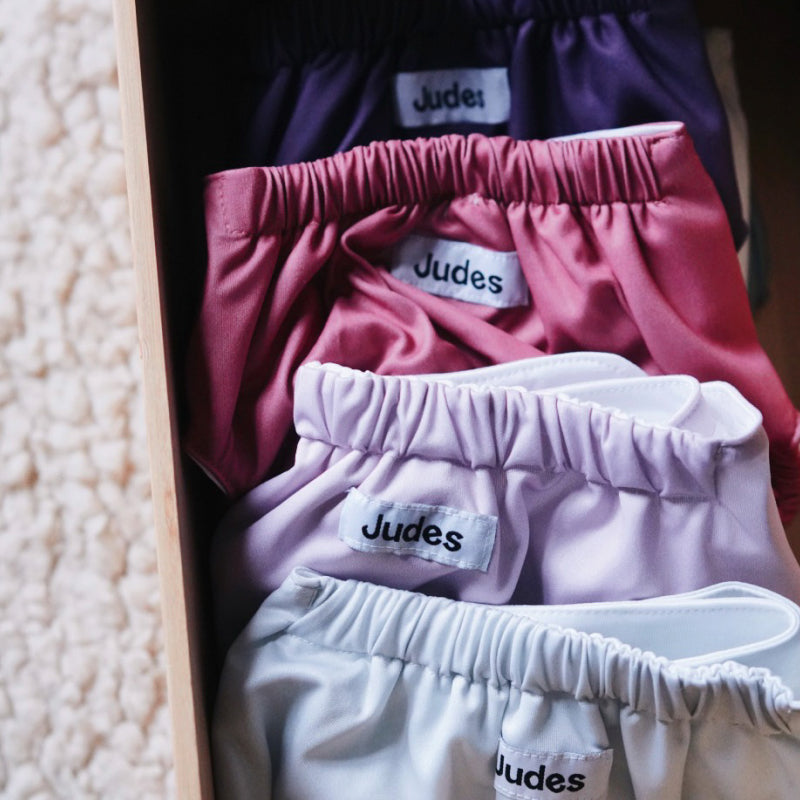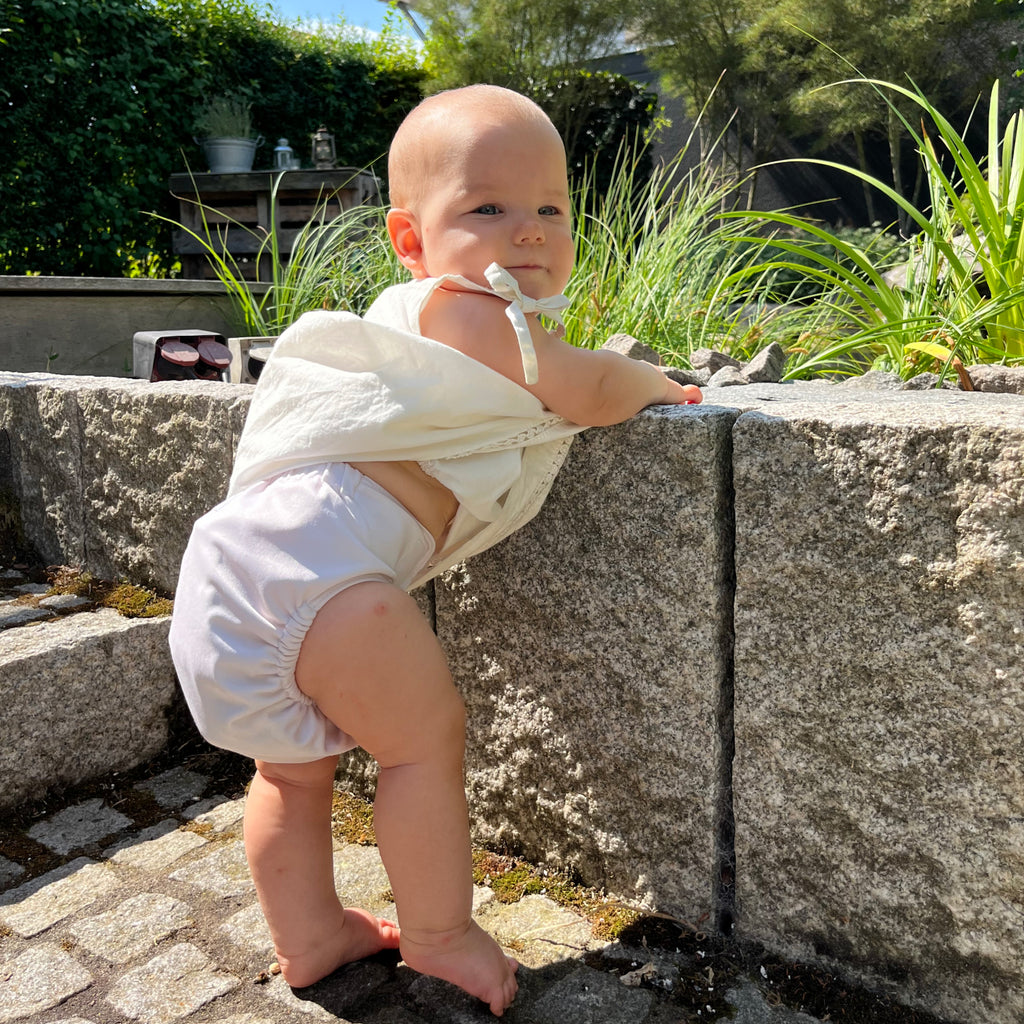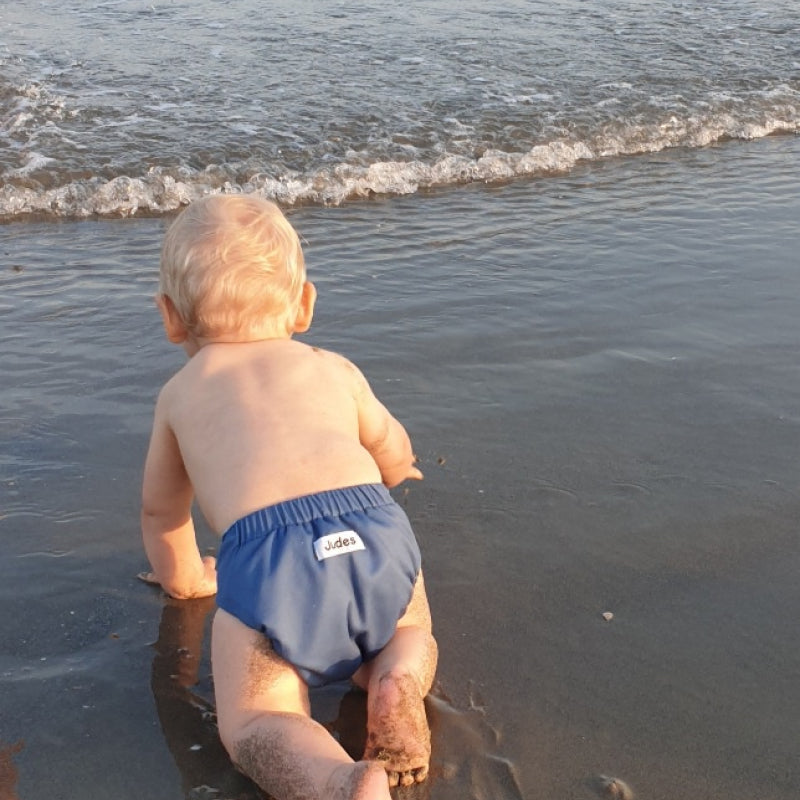Cloth Diapers – A Comprehensive Guide for Modern Parents
Updated on:
Photo by @theothercara
Welcome to the world of cloth diapers – a subject that is becoming increasingly relevant for modern parents who value sustainability, health, and conscious consumption. Perhaps you are just beginning your journey as a parent or are wondering how you can reduce your family's ecological footprint. Cloth diapers play a central role in this, as they offer an eco-friendly and gentle alternative to conventional disposable diapers.
What cloth diaper systems are there? There are several cloth diaper systems (AIO, AI2,...), each with unique features and different characteristics. Each system has its specific advantages and is tailored to the varying needs and preferences of families. Judes offers a solution that combines the best of various cloth diapers and is particularly easy to use.
In this article, we want to show you that switching to cloth diapers can be easy and offer several practical advantages for family life. We guide you through the various cloth diaper systems, explain their application, and provide tips on how best to use and care for them. Our goal is to demonstrate that sustainability and simplicity can go hand in hand – just like with Judes, where we are dedicated to developing simple, sustainable diapers for everyday family life.
Cloth diapers are more than just an alternative to disposable diapers – they are a choice for a conscious lifestyle that prioritizes your baby's health and the preservation of our planet. Discover in this article how cloth diapers can help make daily life easier by shortening changing times, saving the daily walk to the trash bin, and positively influencing your child's health.
What are cloth diapers and how do they differ from disposable diapers?
Cloth diapers are a reusable and environmentally friendly alternative to conventional disposable diapers. They are made from natural or synthetic materials that are absorbent and washable, so they can be reused over and over. The core of every cloth diaper is the absorbent liner, which absorbs liquids, while a waterproof outer layer ensures the baby's clothing remains dry.
The main difference from disposable diapers lies in sustainability and reusability. Unlike disposable diapers, which end up in the trash after a single use and create a substantial amount of waste, cloth diapers can be reused for years and even serve multiple children. This not only significantly reduces waste but is also considerably more cost-effective.
Another essential difference is in the materials. Disposable diapers contain chemicals such as absorbents and fragrances which can irritate the baby's skin. Cloth diapers, on the other hand, are made from skin-friendly materials like organic cotton, bamboo, or hemp, which are gentler on the baby's sensitive skin and minimize allergy risks.
Furthermore, cloth diapers offer a cost-efficient solution for families. Although the initial investment can be higher, parents save money in the long run as there is no need to constantly purchase new disposable diapers. The fact that cloth diapers can be passed on to other diapering children underscores the cost difference. They also offer a wide range of designs and systems that allow the diapers to be customized to the needs of the baby and the family. An additional advantage is that children who are diapered with cloth diapers become potty trained significantly earlier.
Thus, cloth diapers represent not only an environmentally conscious choice but also an investment in the health and well-being of the baby. They stand for a responsible use of our natural resources and for the decision to actively contribute to waste reduction.
The different types of cloth diaper systems
The world of cloth diapers offers an impressive variety of systems that differ in their functionality, application, and care. However, this variety can quickly overwhelm parents, which is why Judes Family has developed a simple solution. Nonetheless, we would like to give you a brief overview of the most common systems:
Cloth diapers from Judes
Judes aims to be the simplest option among cloth diaper systems. They are ideal for parents who value functionality and saving time. They combine the advantages of all cloth diaper systems into a single product: they are absorbent and leak-proof, easy to change, skin-friendly due to organic natural materials, and comfortable for the child. The cloth diapers from Judes are the result of loving development work and the desire to offer families an eco-friendly and practical solution for everyday diaper use. With a clear focus on user-friendliness, sustainability, and comfort, the cloth diapers from Judes are setting new standards in baby hygiene.
Advantages of Judes:
- Easy to use: Judes' cloth diapers are designed to be changed just as easily—with the same steps—as a disposable diaper. This means that changing is quick, and parents, grandparents, or caregivers do not have to readjust.
- Coordinated system: Judes is a self-contained, perfectly coordinated system. While the fold and snap inserts of other diapers often have generic formats so they can be combined with each other, everything at Judes is developed exclusively for its own system: from the inner diaper, to the Poo Paper, to the wet bag. All components contribute to keeping them easy to use, even in stressful everyday life—from changing the diaper to washing.
- Hygienic: Judes has developed its own Poo Paper, which is particularly large and firm. This Poo Paper safely catches the stool so that it can be disposed of separately from the diaper. The diaper bag is also designed for hygienic washing: simply open the zipper at the bottom, and the used diapers tumble out by themselves during washing.
- Skin-friendly, thanks to inner diaper made from 100% organic cotton: The particularly absorbent inner diaper is made from high-quality organic cotton. This not only guarantees excellent absorbency but also a comfortable fit for the sensitive baby skin.
- Leak-proof and absorbent: Thanks to the innovative fabric and double cuffs, the diapers remain leak-proof for up to 12 hours, making them ideal for nighttime or longer outings.
- Slim on the baby's bottom: The innovative weaving allows Judes to remain particularly slim despite high absorbency.
- Overpants as a moisture barrier: The innovative diaper overpants made from PUL (polyurethane) serves as an effective moisture barrier, ensuring that the baby's clothing stays dry even with prolonged wear.
- Boosters for extra absorbency: If needed, additional boosters for diapers can enhance the diaper's absorbency, making Judes leak-proof even over longer periods.
- Flexible cuffs: The flexible cuffs at the back and legs ensure a perfect fit that adapts to the baby's movements while maximizing protection against leaks.
- Customer service & diaper coaching: A particular feature is the helpful customer service. Judes has resolved not to leave parents alone with their diapers. In addition, the purchase of a large set includes Judes Family diaper coaching, where the friendly team at Judes ensures that diapering with Judes makes everyone happy.
Disadvantages of Judes:
- Initial investment: Compared to disposable diapers, Judes initially incur higher costs. However, this does develop into a worthwhile investment over time.
So, Judes cloth diapers offer a simple, environmentally friendly, comfortable and reliable diaper solution that meets the needs of modern families. They combine the best of nature and innovation, making the transition to cloth diapers not only easy but also convincingly effective. When parents buy Judes eco-friendly reusable cloth diapers, they are choosing a diaper designed not only for the child but also for the benefit of the environment.
All-In-One Diapers
As the name suggests, All-In-One Diapers (AIO) combine all the elements of a cloth diaper into a single product: The absorbent layer is firmly connected to the waterproof outer layer, and additional inserts are often already integrated for increased absorbency.
This system initially sounds particularly simple but often comes with problems in practice.
Advantages of All-In-One Diapers:
- Quick changing: AIO diapers are changed like a disposable diaper. Since no separate parts need to be assembled or sorted after washing, AIO diapers save valuable time.
- Ideal for travel: AIO diapers are a good solution for traveling and on trips.
Disadvantages:
- Often not leak-proof: With cloth diapers, it is important for the absorbent part to be individually adjusted to the child's body. The simple design is a disadvantage of the AIO, as the absorbent part is firmly connected to the waterproof outer layer. This often results in poor leak protection.
- Drying time: Due to their design, AIO diapers have longer drying times than other systems. Not enough air reaches the absorbent area of the diaper when drying.
- Price: AIO diapers are often more expensive to purchase than other cloth diaper systems. Due to the long drying times and low flexibility, larger quantities of diapers are needed compared to other cloth diaper systems.
Pocket Diapers
Pocket diapers are a cloth diaper system that focusses on flexibility. They consist of a waterproof outer layer and an inner layer, usually made of skin-friendly material. Between these two layers is an opening through which one or more absorbent inserts are placed into the so-called "pocket."
Advantages of Pocket Diapers:
- Adjustable absorbency: The ability to vary the number and type of inserts makes pocket diapers particularly adaptable. They can be equipped according to your requirements for longer sleep periods or for kids who drink heavily.
- Quick drying: Since the inserts can be removed from the pocket, pocket diapers dry faster than All-In-One diapers. This is particularly beneficial in climates with longer naturaldrying times.
- Effective cleaning: The separation of insert and diaper simplifies the washing process and helps clean the diapers more thoroughly.
Disadvantages:
- Additional steps when changing: Folding and inserting the absorbent inserts into the pocket require an additional step before use, which some may find less practical.
- Adjustment requires practice: Correct inserting and folding the inserts to avoid leaks may require some practice initially.
- Cost: More covers are needed here, as they must be washed after every use.
- Often not leak-proof: Again, the "rigid" system leads to the diapers not being as leak-proof. The insert is not adjusted to the child but is limited to the available space in the pocket.
- Bulky diaper package: The rigid pocket diaper often results in a large diaper bum. This can cause the baby to be uncomfortable when lying down. Also, clothing often needs to be purchased in larger sizes and thus may not fit optimally.
- Hygiene: Since the insert must always be removed from the pocket during diaper change, direct contact with the child's excreta is unavoidable.
Pocket diapers might be a solution for parents who value quick drying and adjustable absorbency. It's important for parents using these diapers to be practical-minded and make time for making individual adjustments, so the diapers fit the child well and do not leak.
Covers and Inserts
The system of covers and inserts or prefolds is one of the more traditional and versatile methods for cloth diapers. Prefolds are rectangular fabric layers that are folded multiple times and used as absorbent inserts. Covers serve as a waterproof outer layer, keeping the prefolds in place and the baby's clothing dry.
Advantages of Covers and Prefolds:
- Cost-effectiveness: This system is often more affordable compared to other cloth diaper systems, as prefolds and covers can be reused separately. The covers do not need to be washed after every diaper change if they didn't come into contact with excreta, which reduces the number of covers needed. With this system, prefolds, muslin clothes and even washcloths can be used as inserts.
- Adjustable absorbency: Prefolds or other inserts can be folded in various ways to increase absorbency where it's most needed. Additional inserts or boosters can be added for longer sleep periods or for babies who are heavy wetters.
- Quick drying: Since prefolds and covers can be dried separately, they offer a shorter drying time than All-In-One or pocket diapers.
Disadvantages:
- More steps required: Folding and applying the prefolds can be particularly challenging for diaper beginners and requires some practice. Different folding methods are suitable for different situations—and there are even folding techniques specifically tailored to the child's gender. Always choosing the right technique and folding it correctly doesn't just take time but can also be complicated.
- Managing multiple parts: Since this system consists of several separate components, managing and organizing the diaper parts can be somewhat more tricky.
- Material overview: A wide variety of materials for inserts are available on the market. Apart from cotton, there are prefolds and boosters made from bamboo, hemp, microfiber, Zorb, and many more, each with different properties and absorption strengths. It requires thorough research to keep an overview.
- Bulky diaper package: Due to the many parts, especially the foldable inserts, a large diaper bum often results. This can cause discomfort for the baby when lying down. Additionally, clothing needs to be purchased in larger sizes and often does not fit optimally.
Covers and prefolds are an excellent choice for environmentally conscious families looking for a cost-effective, efficient, and flexible diapering system. Their durability and versatility make them a preferred choice for parents who want to maintain their sustainable lifestyle even after the baby period ends. The ability to customize absorbency and the ease of care are additional advantages of this proven cloth diaper system.

Snap-In-Ones
Snap-In-One Diapers (SIO) offer another solution in the field of cloth diapers, combining the advantages of All-In-One and pocket diapers. They consist of a waterproof cover and one or more inserts that are fastened in the cover with snaps.
Advantages of Snap-In-One Diapers:
- Adjustable absorbency: Similar to pocket diapers, different inserts can be used in Snap-In-One diapers as needed to achieve optimal absorbency. This is particularly practical for longer trips or nighttime.
- Less laundry: Since the covers and inserts can be washed separately and the covers do not need to be washed after each use, the amount of laundry is reduced, thus lowering water and energy consumption.
Disadvantages:
- Time-consuming to use: The inserts must be inserted and removed from the cover using the snaps.
- Upfront costs: The costs for Snap-In-One diapers can be higher than for simple prefold or flat diaper systems, though they offer the potential for long-term savings through their durability and reusability.
- Drying time: Although the separate drying of inserts and covers generally allows faster drying times compared to All-In-One diapers, the drying time of the inserts can vary depending on the material.
- Preparation time: Snap-In-Ones require a bit more preparation time than other cloth diaper systems. The inserts need to be adjusted and fastened in the cover as needed.
- Bulky diaper package: Due to the many parts, a large diaper bum often results. This can lead to the baby being uncomfortable. Additionally, clothing in larger sizes is needed.
- Durability: Snaps often rip out or become deformed from hot washing and drying, limiting the durability.
Snap-In-One diapers are a choice for parents who appreciate the ease of handling of All-In-One diapers but also want the flexibility to adjust absorbency individually. Due to their design, they have become a pragmatic solution for everyday family life, though they require some time and patience.
All-In-Three
All-In-Three (AI3) systems represent another development in the field of cloth diapers, focusing particularly on flexibility and modularity. These diapers consist of three parts: an outer shell (cover, usually wool), an absorbent insert, and a waterproof inner tub into which the absorbent insert is placed.
Advantages of All-In-Three Systems:
- Maximum flexibility: AI3 systems offer high flexibility due to their modular design. Depending on the need, the insert and tub can be replaced without changing the entire diaper. This is particularly practical for slightly damp inserts or for quickly preparing the diaper for the next use.
- Efficient cleanliness: The replaceable tub makes cleaning easier and provides additional leak protection. This is especially beneficial for sensitive skin or to prevent skin irritation.
- Economy and environmental protection: As not all components of the diaper need to be washed with each change, AI3 systems help reduce detergent and water consumption. This benefits not only the wallet but also the environment.
Disadvantages:
- Initial investment: The initial costs for AI3 systems can be higher as multiple components are needed for an effective diaper system. However, these costs pay off over time through the long usage duration and savings on ongoing costs.
- Assembly required: Although assembling the diaper parts is usually quick, it can be seen as a drawback, especially in stressful situations or when on the go. The challenge is in placing the tub so that nothing can go wrong.
- Bulky diaper package: Due to the many parts, a large diaper bum often results. This can cause the baby to be uncomfortable when lying down. Additionally, clothing in larger sizes is needed.
All-In-Three systems are ideal for parents who value an eco-friendly diapering solution without compromising on comfort and flexibility. They offer a good solution for everyday use, support healthy skin development for the baby, and promote a conscious lifestyle through their sustainable design.

Photo by @madame.vio
Practical Tips for Using Cloth Diapers
Using cloth diapers can be a challenge at first, especially when transitioning from disposable diapers. However, with the right tips and a little practice, it quickly becomes an easy routine. Here are practical tips for using cloth diapers, from Judes and beyond.
Putting on cloth diapers:
- With Judes cloth diapers, putting them on is as easy as with a disposable diaper, thanks to their thoughtful design. The diapers are designed to make changing as easy as possible for parents and caregivers. Ensure that the diaper fits perfectly and that the elastic cuffs at the back and legs provide an optimal fit to prevent leaks. Note that, unlike disposable diapers, cloth diapers should sit higher up the waist and more loosely; you should be able to comfortably fit two fingers between your baby's skin and the diaper at the waist.
- For other systems like prefolds or Snap-In-Ones, it's important to familiarize yourself with the various folding techniques and know how to properly insert the inserts. There are many helpful guides and videos online that can make handling these systems easier.
Washing and care:
- Washing routine: Develop a regular washing routine. Cloth diapers should be washed about every 3–4 days. Use an environmentally friendly, skin-compatible detergent for cloth diapers and avoid fabric softeners, as they can affect the absorbency of the diapers.
- Temperature: Most cloth diapers can be washed at 40 - 60 °C. Always check the manufacturer's specific washing instructions to ensure the longevity of your diapers.
Storing used cloth diapers:
- Dry storage: Store used cloth diapers in a dry bucket or large wet bag until washing. Avoid soaking the diapers, as this can lead to odor development and wear.
- Hygiene: Ensure that the storage area for the used diapers is clean and dry to prevent the formation of bacteria and mold.
Follow these tips to make the most of cloth diapers and contribute positively to environmental protection. Cloth diapers are not only a sustainable choice but, with the right care, also a practical and healthy option for your baby.
Useful Knowledge about Cloth Diapers
Now that you know all about the different cloth diaper systems, we would like to take it a step further. Below, we will show you what impact cloth diapers have on the development of babies and our environment.
Environmental Impact: Cloth Diapers vs. Disposable Diapers
The use of cloth diapers as opposed to disposable diapers has significant positive impacts on the environment. Due to the reusability of cloth diapers, a substantial amount of waste is reduced. A child uses about 5,000 to 6,000 disposable diapers from birth until being potty trained. Disposable diapers end up in landfills and incinerators but cannot be fully incinerated: a toxic slag remains, which is stored as hazardous waste in abandoned mines. This results in significant costs and environmental risks for future generations (Sources: Süddeutsche Zeitung; Tagesschau; Deutschlandfunkkultur; Hessenschau). In contrast, a set of cloth diapers can be used for several children over years, drastically reducing the amount of waste.
Furthermore, cloth diapers conserve resources. The production of disposable diapers consumes large amounts of water, energy, and raw materials such as pulp, plastic, and chemicals. Cloth diapers, however, require overall fewer resources over their lifetime, despite the necessary washing processes. Using organic cotton and other sustainable materials in cloth diapers further reduces environmental impact.
Finally, cloth diapers contribute to the reduction of CO₂ emissions by decreasing the production and disposal of disposable diapers. By choosing cloth diapers, parents make a valuable contribution to protecting the environment and promote a more sustainable future for their children.
Diaper-Free Earlier and Healthy Baby Development with Cloth Diapers
Cloth diapers not only have positive effects on the environment, but they also support the physical development and well-being of the baby in various ways:
Out of Diapers Almost 1 Year Earlier:
Children who are diapered with Judes are potty trained almost 1 year earlier, on average, than children who use disposable diapers. This was shown in a survey conducted by Judes Family with over 5,000 parents. The reason is that cloth diapers provide wetness feedback - the child immediately feels when they wet themselves and can understand this process earlier. Disposable diapers, however, are designed to feel permanently dry.
This aligns with my personal experience: Both children discarded their diapers at just 14 months of age and could clearly express their needs. In my circle of friends, where all the children wore disposable diapers, it took at least twice as long for the children to show the first signs - often accompanied by numerous mishaps and frustration.
Freedom of Movement and Development:
Cloth diapers are often softer and offer more freedom of movement than stiff disposable diapers. This flexibility can promote the baby's motor development by allowing them to kick, crawl, and explore their environment without restriction. The good fit and adjustable sizes of cloth diapers help the baby to feel comfortable and move freely.
Hip Development:
With their slightly padded structure, cloth diapers support a natural hip position, which is important for healthy hip development. The legs can move freely and in an optimal position for hip maturation.
Skin Health:
Cloth diapers are made from breathable materials that keep the skin dry and allow air circulation. This can reduce the risk of diaper dermatitis and other sorts of skin irritation. The use of natural materials like organic cotton also reduces the risk of allergic reactions, as cloth diapers are especially gentle on the baby's sensitive skin.

Conclusion
Choosing cloth diapers is much more than just a choice of diaper type—it is a conscious decision for the health of your baby, the environment, and the promotion of a sustainable future. By using cloth diapers, such as the innovative solutions from Judes, parents can not only save a significant amount of waste and conserve resources but also support the physical development and well-being of their baby.
Cloth diaper systems offer a variety of options—from All-In-One to pocket diapers to covers and prefolds—providing a customizable solution for every family. The easy handling and care of cloth diapers, especially with products from Judes, make the transition from disposable diapers easy and practical.
The use of cloth diapers not only has a positive impact on the freedom of movement, hip development, and the skin health of the baby, but is also environmentally friendly and promotes the healthy development of the child. Cloth diapers are thus an investment in the future of our children and the planet.
Sustainability and conscious consumption are becoming increasingly important. Cloth diapers offer an effective way to embody these values in everyday life. Choosing cloth diapers is a significant step towards a responsible lifestyle that considers the needs of our children and the planet alike.

